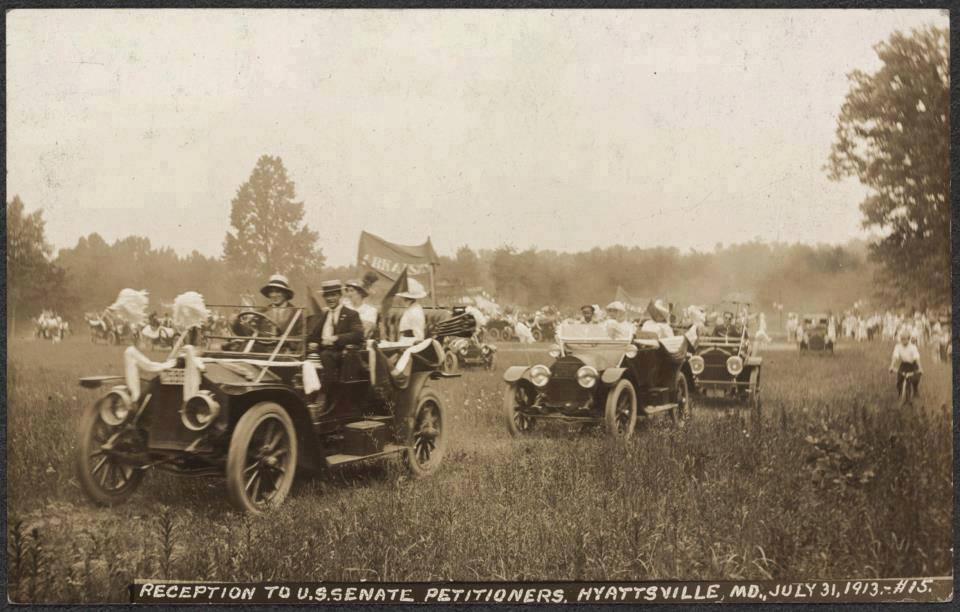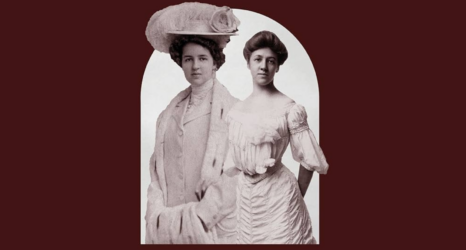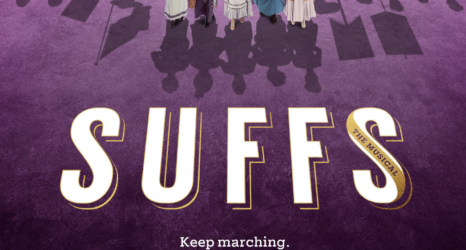
Today in Feminist History is our daily recap of the major milestones and minor advancements that shaped women’s history in the U.S.—from suffrage to Shirley Chisholm and beyond. These posts were written by, and are presented in homage to, our late staff historian and archivist, David Dismore.
July 31, 1913: It was certainly an inspiring sight earlier today when a huge caravan of over 60 decorated automobiles, carrying suffrage activists and 85,000 signatures on suffrage petitions gathered from citizens of all 48 States, assembled in Hyattsville, Maryland.

They then drove into D.C. to deliver their petitions to the U.S. Senate. These advocates for our cause had been traveling around various parts of the country in small caravans until converging on Hyattsville to begin the final procession.
The town displayed its enthusiasm for the cause with a widespread showing of support by local residents. This was actually Hyattsville’s second encounter with a major suffrage event this year. “General” Rosalie Jones and her hardy band of suffrage hikers were met by the town’s mayor, and given a luncheon on February 27th while on their way from Newark, New Jersey, to Washington, D.C., to take part in a huge suffrage parade on March 3rd.
Today’s procession began after a rally in a Hyattsville ball park, and proceeded down roads that were merely dusty, a great improvement over the mud the hikers slogged through in February. Finally, the automobiles made their way down Pennsylvania Avenue in D.C. In the lead vehicle was Alice Paul, head of the National American Woman Suffrage Association’s Congressional Committee. She was followed by other N.A.W.S.A. officers, and supportive members of the U.S. Senate’s Woman Suffrage Committee.
The petitioners were welcomed to the Capitol by Senator George E. Chamberlain, Democrat of Oregon, the principal sponsor of the Susan B. Anthony (woman suffrage) Amendment. The petitions were then formally presented to the Senate by Senator Robert Owen, Democrat of Oklahoma, with ten other Senators also making speeches urging the amendment’s passage, as 500 suffrage supporters packed the gallery to listen.
Today’s events ended with a magnificent banquet hosted by N.A.W.S.A.’s Congressional Committee at the Brighton Apartment House. More than twenty members of Congress were present, and Senator Charles Thomas, Democrat of Colorado, who heads the Senate Woman Suffrage Committee, encouraged everyone by saying that “Votes for Women” in the U.S. is ‘”as inevitable as the law of gravity.” When Alice Paul asked for contributions, $1,051 was pledged in just ten minutes. She then announced that her committee was planning to publish a suffrage newspaper to further the fight and keep members up on the latest developments.
Lucy Burns believes that it is more efficient to concentrate on getting a 2/3 majority of 96 Senators and 435 House members to support a Constitutional Amendment, which will then be ratified by 36 State legislatures, than to try to persuade millions of male voters in State-by-State campaigns, and that women now have enough voting power in suffrage States to influence legislation on a national level: “There are over four million women in the United States who can vote. One-sixth of the Electoral Vote is cast in States where women have the vote.” Burns is not willing to accept the usual explanations for delay: “Every session of Congress, it appears, is ‘the busiest in history.’ The time for us to get action is now.”
If actions like today’s can be kept up, the strong momentum that our cause has gained in just the past few years will be reinforced, and even more gains can be expected soon!





